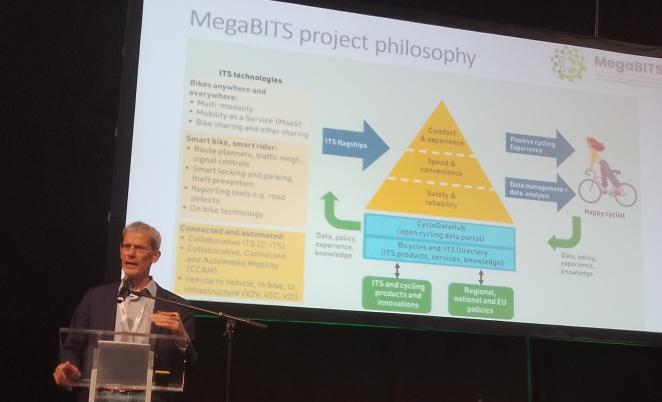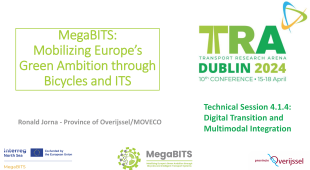We asked Ronald Jorna, the project manager of MegaBITS, about how Intelligent Transport Systems are making cycling safer, more comfortable, and convenient, and the significant role MegaBITS plays in driving these advancements. Read the full interview below.

Ronald Jorna Presenting the MegaBITS Project during the Transport Research Arena in Dublin
Ronald Jorna, can you tell me about MegaBITS and your role in the project?
MegaBITS promotes cycling through Intelligent Transport Systems (ITS), making cycling safer, more comfortable, and convenient. It's an Interreg North Sea initiative implementing ITS technologies across five flagship projects on a local and regional level. Each pilot project gets evaluated to determine where and how it works best and is shared afterwards with other cities.
The project aims for a 10% increase in cycling kms and an 8.8% decrease in CO2 emissions. As the Project Manager, hired by the province of Overrijsel, I ensure MegaBITS fulfills its commitments.
What exactly does ITS technology mean, and why is it important in cycling?
ITS (or Intelligent Transport Systems) for cycling, encompasses a range of technologies aimed at improving comfort, safety, and convenience. It utilizes digital solutions to enhance cycling infrastructure and operations.
A good example is intelligent bike parking systems that inform cyclists of available spots, and at the same time providing policymakers with useful information. If they see that bike parking is consistently full, then it's time to build additional bicycle parking facilities. Other apps can offer optimized cycling routes with real-time information about traffic conditions, while smart cameras analyse intersections for safety, identifying areas where near accidents occur and providing a clear picture for implementing safety measures. However, this process can take some time.
ITS also improves convenience with features like the green wave, which consists of smart traffic lights that prioritize cyclists, reducing wait times and improving traffic flow. Additionally, data-driven insights enable cities to enhance cycling infrastructure based on usage patterns and safety considerations.
What are the challenges in ITS for cycling?
One of the primary challenges is raising awareness and demonstrating the possibilities of ITS among policymakers regarding its potential for cycling. Many traditional approaches to cycling infrastructure focus on physical solutions rather than digital innovations. I want policymakers to understand that safety can also be improved through digital means, not just by building separate bike lanes. Additionally, enhancing comfort and ease of use can be achieved through various applications, such as those indicating bike parking availability.
In rural areas, dynamic lighting in natural settings, where lights activate only when a cyclist approaches, can be beneficial for example too. This is a project we previously implemented in BITS, the predecessor project to MegaBITS.
Standardizing data formats and definitions across different regions is also crucial for effective ITS implementation.
Can you tell me more about the cycling data hub Imec works on in the context of MegaBITS?
The cycling data space will be an open data platform where organizations share cycling-related data to enhance urban mobility. It will start with bicycle counting information but can be extended with other relevant cycling data. For instance, cities can share information about bike parking locations, the number of cyclists, and cycling routes.
This data space enables the development of innovative apps and services that benefit cyclists. For example, someone can build an app showing all bike parking locations and their availability in Brussels. This creates added value, but the data must be standardized in the same format for optimal functionality. In this standardisation process, we cooperate with the European project NAPCORE, which has harmonisation as its core business.
How does your ideal future city look like?
In my ideal future city, cycling would play a much larger role in urban transportation. I hope ITS can contribute to improving cycling, as it's just one aspect of the whole ecosystem that also includes safe cycling infrastructure, education on cycling, and more. We aim to add a digital layer that enhances cycling safety, comfort, and convenience. Ultimately, this would result in more bicycle use, improved air quality, and a more liveable urban environment.
Recently, MegaBITS project manager Ronald Jorna delivered a speech at the Transport Research Arena (TRA) 2024 conference in Dublin, pledging for more attention to smart cycling and cycling data in local and regional cycling policy. More information here.

